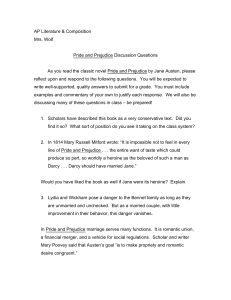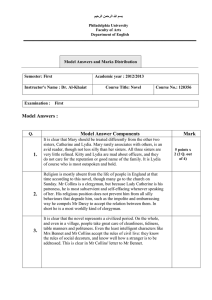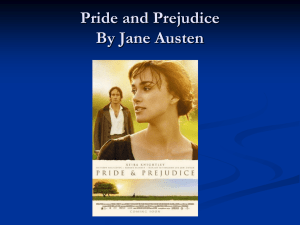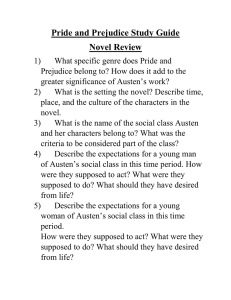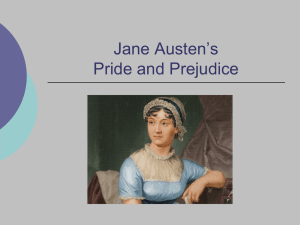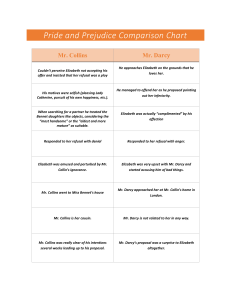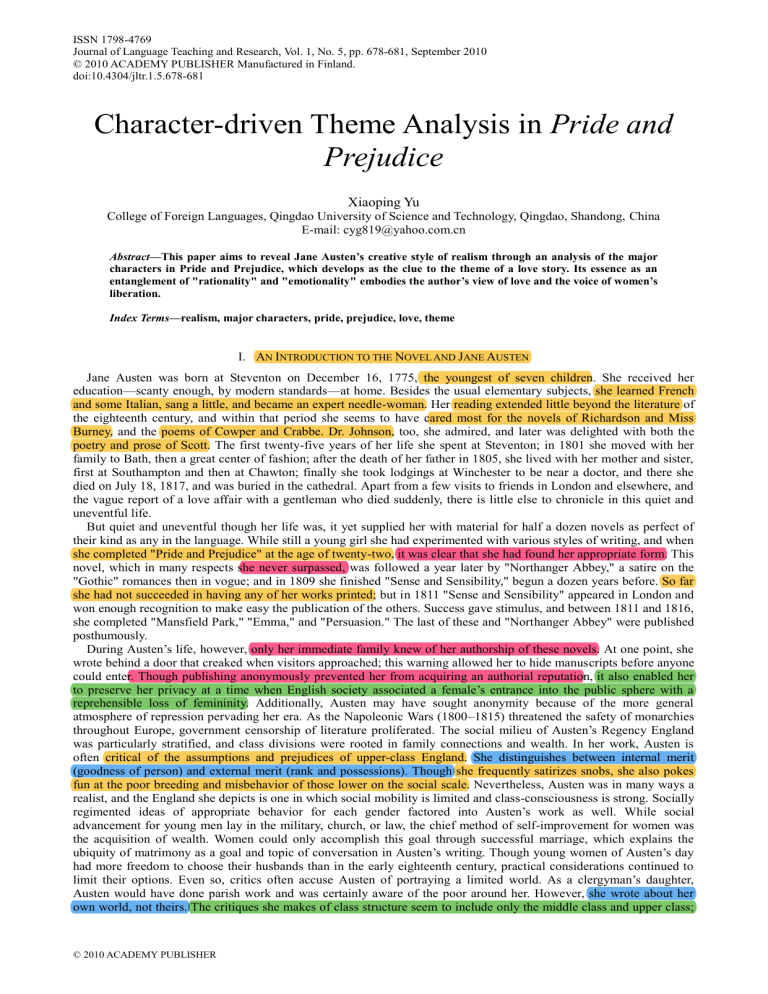
ISSN 1798-4769 Journal of Language Teaching and Research, Vol. 1, No. 5, pp. 678-681, September 2010 © 2010 ACADEMY PUBLISHER Manufactured in Finland. doi:10.4304/jltr.1.5.678-681 Character-driven Theme Analysis in Pride and Prejudice Xiaoping Yu College of Foreign Languages, Qingdao University of Science and Technology, Qingdao, Shandong, China E-mail: cyg819@yahoo.com.cn Abstract—This paper aims to reveal Jane Austen’s creative style of realism through an analysis of the major characters in Pride and Prejudice, which develops as the clue to the theme of a love story. Its essence as an entanglement of "rationality" and "emotionality" embodies the author’s view of love and the voice of women’s liberation. Index Terms—realism, major characters, pride, prejudice, love, theme I. AN INTRODUCTION TO THE NOVEL AND JANE AUSTEN Jane Austen was born at Steventon on December 16, 1775, the youngest of seven children. She received her education—scanty enough, by modern standards—at home. Besides the usual elementary subjects, she learned French and some Italian, sang a little, and became an expert needle-woman. Her reading extended little beyond the literature of the eighteenth century, and within that period she seems to have cared most for the novels of Richardson and Miss Burney, and the poems of Cowper and Crabbe. Dr. Johnson, too, she admired, and later was delighted with both the poetry and prose of Scott. The first twenty-five years of her life she spent at Steventon; in 1801 she moved with her family to Bath, then a great center of fashion; after the death of her father in 1805, she lived with her mother and sister, first at Southampton and then at Chawton; finally she took lodgings at Winchester to be near a doctor, and there she died on July 18, 1817, and was buried in the cathedral. Apart from a few visits to friends in London and elsewhere, and the vague report of a love affair with a gentleman who died suddenly, there is little else to chronicle in this quiet and uneventful life. But quiet and uneventful though her life was, it yet supplied her with material for half a dozen novels as perfect of their kind as any in the language. While still a young girl she had experimented with various styles of writing, and when she completed "Pride and Prejudice" at the age of twenty-two, it was clear that she had found her appropriate form. This novel, which in many respects she never surpassed, was followed a year later by "Northanger Abbey," a satire on the "Gothic" romances then in vogue; and in 1809 she finished "Sense and Sensibility," begun a dozen years before. So far she had not succeeded in having any of her works printed; but in 1811 "Sense and Sensibility" appeared in London and won enough recognition to make easy the publication of the others. Success gave stimulus, and between 1811 and 1816, she completed "Mansfield Park," "Emma," and "Persuasion." The last of these and "Northanger Abbey" were published posthumously. During Austen’s life, however, only her immediate family knew of her authorship of these novels. At one point, she wrote behind a door that creaked when visitors approached; this warning allowed her to hide manuscripts before anyone could enter. Though publishing anonymously prevented her from acquiring an authorial reputation, it also enabled her to preserve her privacy at a time when English society associated a female’s entrance into the public sphere with a reprehensible loss of femininity. Additionally, Austen may have sought anonymity because of the more general atmosphere of repression pervading her era. As the Napoleonic Wars (1800–1815) threatened the safety of monarchies throughout Europe, government censorship of literature proliferated. The social milieu of Austen’s Regency England was particularly stratified, and class divisions were rooted in family connections and wealth. In her work, Austen is often critical of the assumptions and prejudices of upper-class England. She distinguishes between internal merit (goodness of person) and external merit (rank and possessions). Though she frequently satirizes snobs, she also pokes fun at the poor breeding and misbehavior of those lower on the social scale. Nevertheless, Austen was in many ways a realist, and the England she depicts is one in which social mobility is limited and class-consciousness is strong. Socially regimented ideas of appropriate behavior for each gender factored into Austen’s work as well. While social advancement for young men lay in the military, church, or law, the chief method of self-improvement for women was the acquisition of wealth. Women could only accomplish this goal through successful marriage, which explains the ubiquity of matrimony as a goal and topic of conversation in Austen’s writing. Though young women of Austen’s day had more freedom to choose their husbands than in the early eighteenth century, practical considerations continued to limit their options. Even so, critics often accuse Austen of portraying a limited world. As a clergyman’s daughter, Austen would have done parish work and was certainly aware of the poor around her. However, she wrote about her own world, not theirs. The critiques she makes of class structure seem to include only the middle class and upper class; © 2010 ACADEMY PUBLISHER JOURNAL OF LANGUAGE TEACHING AND RESEARCH 679 the lower classes, if they appear at all, are generally servants who seem perfectly pleased with their lot. This lack of interest in the lives of the poor may be a failure on Austen’s part, but it should be understood as a failure shared by almost all of English society at the time. The most remarkable characteristic of Jane Austen as a novelist is her recognition of the limits of her knowledge of life and her determination never to go beyond these limits in her books. She describes her own class, in the part of the country with which she was acquainted; and both the types of character and the events are such as she knew from first-hand observation and experience. But to the portrayal of these she brought an extraordinary power of delicate and subtle delineation, a gift of lively dialogue, and a peculiar detachment. She abounds in humor, but it is always quiet and controlled; and though one feels that she sees through the affectations and petty hypocrisies of her circle, she seldom becomes openly satirical. The fineness of her workmanship, unexcelled in the English novel, makes possible the discrimination of characters who have outwardly little or nothing to distinguish them; and the analysis of the states of mind and feeling of ordinary people is done so faithfully and vividly as to compensate for the lack of passion and adventure. She herself speaks of the "little bit (two inches wide) of ivory on which I work," and, in contrast with the broad canvases of Fielding or Scott, her stories have the exquisiteness of a fine miniature. The novel was published in 1813 but was completed in the 1797 and initially titled First Impressions. It is set primarily in the village of Longbourn 1 mile from Meryton in Hertfordshire in England. In general, Austen occupies a curious position between the eighteenth and nineteenth centuries. Her favorite writer, whom she often quotes in her novels, was Dr. Samuel Johnson, the great model of eighteenth-century classicism and reason. Her plots, which often feature characters forging their respective ways through an established and rigid social hierarchy, bear similarities to such works of Johnson’s contemporaries as Pamela, written by Samuel Richardson. Austen’s novels also display an ambiguity about emotion and an appreciation for intelligence and natural beauty that aligns them with Romanticism. In their awareness of the conditions of modernity and city life and the consequences for family structure and individual characters, they prefigure much Victorian literature (as does her usage of such elements as frequent formal social gatherings, sketchy characters, and scandal). II. THE PLOT OF THE NOVEL Perhaps the most famous opening lines from any nineteenth-century novel are the opening lines to Jane Austen's Pride and Prejudice: "It is a truth universally acknowledged, that a single man in possession of a good fortune, must be in want of a wife." These words are spoken by Mrs. Bennet to Mr. Bennet on the news that a gentleman of fortune has just moved to Netherfield Park, a nearby estate. The Bennets begin this story with a peculiar problem: they have five unmarried daughters and no sons. Their estate is entailed, or restricted in inheritance, to Mr. Collins, a family cousin. Upon Mr. Bennet's death, Mr. Collins will inherit the family lands, which will leave the Bennet daughters without a home or money. It becomes vital, therefore, that at least one of the daughters marries well in order to support and house their sisters (and mother if she is still alive) should they not be able to marry. Pride and Prejudice is undoubtedly Jane Austen’s masterpiece, whose plots are about the four marriages, namely Jane and Bingley, Elizabeth and Darcy, Lydia and Wickham, and Lucas and Collins, of which the development of the love between Elizabeth and Darcy is the main focus. Elizabeth rejected Mr. Darcy’s first proposal based on her prejudice at Darcy’s first impression and his disinheriting Wickham as well as his admitted practice of separating her beloved sister Jane and his best friend Bingley. While Darcy mistakenly turned a proposal for marriage into the declaration of his proud feelings towards the inferior, he later wrote a letter in explanation to her about the two matters which Elizabeth accuses of him, which leads to her forgiveness. And her later being informed of Darcy’s significant role in saving the honor of her entire family in terms of making Wickham’s acceptance of marrying her sister Lydia come true after Lydia’s eloping with Wickham, as well as her being warmly accepted by Darcy with hospitality in his house Pemberley leads her to loving him. And when Lady Catherine de Bourgh’s sudden visit to demand her never to accept her nephew Darcy’s love becomes an insult to her, Elizabeth declares its impossibility and finally accepts Darcy’s love at his second proposal. III. ANALYSIS OF MAJOR CHARACTERS Shortly after arriving alone, Bingley brings to Netherfield his two sisters, Miss Bingley and Mrs. Hurst; his brother-in-law, Mr. Hurst; and his friend, Mr. Darcy, who also happens to be wealthy and unmarried. Not wanting to miss a favorable introduction to their new neighbors, Mrs. Bennet pleads with Mr. Bennet to call on Bingley so that she can begin introducing her daughters to him. Initially Mr. Bennet refuses to play any part in matching any one of his daughters with Bingley. He tells his wife that if she is so intent on meeting the newcomers at Netherfield, she must visit Bingley herself. However, prudent manners forbade a woman to call on a strange man, making Mrs. Bennet powerless to begin the process which she hopes will lead to a marriage between one of her daughters and Bingley. Following the pronouncement that Mr. Bennet refuses to call on Bingley, Mrs. Bennet despairs that her daughters will never be able to meet with the eligible bachelor. Yet Mr. Bennet does call on Bingley, beginning the family's acquaintance with him. He takes ironic pleasure in surprising Mrs. Bennet with the news after letting her believe that he would not call on him. The Bennet girls meet the Netherfield party for the first time at a small ball. Bingley proves to be personable and © 2010 ACADEMY PUBLISHER 680 JOURNAL OF LANGUAGE TEACHING AND RESEARCH polite to the local folk, making him instantly well-liked. Darcy, while handsome and noble looking, appears proud and indifferent to participating in the activities of the evening or even socializing with the other guests. The eldest daughter, Jane, is instantly drawn to Bingley, and he seems equally attracted to her. Jane is portrayed as gentle, unselfish, and very mannerly. Elizabeth is also well mannered, but possess a very sharp wit and refuses to be intimidated by anyone. Inclined to be protective of Jane and her family, she nonetheless recognizes the faults of her parents and other sisters. At the assembly, because of a shortage of men who dance, Elizabeth is left sitting. She overhears Bingley encouraging Darcy to dance, suggesting that he ask Elizabeth. Darcy curtly replies that "she is tolerable; but not handsome enough to tempt me; and I am in no humour at present to give consequence to young ladies who are slighted by other men." Elizabeth, though insulted, refuses to give Darcy's comment any weight, instead telling the story to all her friends and ridiculing his pretentious behavior. Jane and Bingley's relationship continues to deepen during family visits, balls, and dinners. His sisters pretend to like Jane, but are appalled by her mother's vulgarities, her younger sisters' wild, loose manners, and their lower economic position among the landed gentry. They find great amusement in making fun of the Bennets behind Jane's back. A particular point of hilarity stems from the way Kitty and Lydia chase after the young military officers stationed locally. Elizabeth Bennet, the second daughter in the Bennet family, and the most intelligent and quick-witted, Elizabeth is the protagonist of Pride and Prejudice and one of the most well-known female characters in English literature. Her admirable qualities are numerous—she is lovely, clever, and, in a novel defined by dialogue, she converses as brilliantly as anyone. Her honesty, virtue, and lively wit enable her to rise above the nonsense and bad behavior that pervade her class-bound and often spiteful society. Nevertheless, her sharp tongue and tendency to make hasty judgments often lead her astray; Pride and Prejudice is essentially the story of how she (and her true love, Darcy) overcome all obstacles—including their own personal failings—to find romantic happiness. Elizabeth must not only cope with a hopeless mother, a distant father, two badly behaved younger siblings, and several snobbish, antagonizing females, she must also overcome her own mistaken impressions of Darcy, which initially lead her to reject his proposals of marriage. Her charms are sufficient to keep him interested, fortunately, while she navigates familial and social turmoil. As she gradually comes to recognize the nobility of Darcy’s character, she realizes the error of her initial prejudice against him. Fitzwilliam Darcy, the son of a wealthy, well-established family and the master of the great estate of Pemberley, Darcy is Elizabeth’s male counterpart. The narrator relates Elizabeth’s point of view of events more often than Darcy’s, so Elizabeth often seems a more sympathetic figure. The reader eventually realizes, however, that Darcy is her ideal match. Intelligent and forthright, he too has a tendency to judge too hastily and harshly, and his high birth and wealth make him overly proud and overly conscious of his social status. Indeed, his haughtiness makes him initially bungle his courtship. When he proposes to her, for instance, he dwells more on how unsuitable a match she is than on her charms, beauty, or anything else complimentary. Her rejection of his advances builds a kind of humility in him. Darcy demonstrates his continued devotion to Elizabeth, in spite of his distaste for her low connections, when he rescues Lydia and the entire Bennet family from disgrace, and when he goes against the wishes of his haughty aunt, Lady Catherine de Bourgh, by continuing to pursue Elizabeth. Darcy proves himself worthy of Elizabeth, and she ends up repenting her earlier, overly harsh judgment of him. Jane Bennet and Charles Bingley, one as Elizabeth’s beautiful elder sister and another Darcy’s wealthy best friend, Jane and Bingley engage in a courtship that occupies a central place in the novel. They first meet at the ball in Meryton and enjoy an immediate mutual attraction. They are spoken of as a potential couple throughout the book, long before anyone imagines that Darcy and Elizabeth might marry. Despite their centrality to the narrative, they are vague characters, sketched by Austen rather than carefully drawn. Indeed, they are so similar in nature and behavior that they can be described together: both are cheerful, friendly, and good-natured, always ready to think the best of others; they lack entirely the prickly egotism of Elizabeth and Darcy. Jane’s gentle spirit serves as a foil for her sister’s fiery, contentious nature, while Bingley’s eager friendliness contrasts with Darcy’s stiff pride. Their principal characteristics are goodwill and compatibility, and the contrast of their romance with that of Darcy and Elizabeth is remarkable. Jane and Bingley exhibit to the reader true love unhampered by either pride or prejudice, though in their simple goodness, they also demonstrate that such a love is mildly dull. Mr. Bennet is the patriarch of the Bennet household—the husband of Mrs. Bennet and the father of Jane, Elizabeth, Lydia, Kitty, and Mary. He is a man driven to exasperation by his ridiculous wife and difficult daughters. He reacts by withdrawing from his family and assuming a detached attitude punctuated by bursts of sarcastic humor. He is closest to Elizabeth because they are the two most intelligent Bennets. Initially, his dry wit and self-possession in the face of his wife’s hysteria make him a sympathetic figure, but, though he remains likable throughout, the reader gradually loses respect for him as it becomes clear that the price of his detachment is considerable. Detached from his family, he is a weak father and, at critical moments, fails his family. In particular, his foolish indulgence of Lydia’s immature behavior nearly leads to general disgrace when she elopes with Wickham. Further, upon her disappearance, he proves largely ineffective. It is left to Mr. Gardiner and Darcy to track Lydia down and rectify the situation. Ultimately, Mr. Bennet would rather withdraw from the world than cope with it. Mrs. Bennet is a miraculously tiresome character. Noisy and foolish, she is a woman consumed by the desire to see her daughters married and seems to care for nothing else in the world. Ironically, her single-minded pursuit of this goal tends to backfire, as her lack of social graces alienates the very people (Darcy and Bingley) whom she tries desperately © 2010 ACADEMY PUBLISHER JOURNAL OF LANGUAGE TEACHING AND RESEARCH 681 to attract. Austen uses her continually to highlight the necessity of marriage for young women. Mrs. Bennet also serves as a middle-class counterpoint to such upper-class snobs as Lady Catherine and Miss Bingley, demonstrating that foolishness can be found at every level of society. In the end, however, Mrs. Bennet proves such an unattractive figure, lacking redeeming characteristics of any kind, that some readers have accused Austen of unfairness in portraying her—as if Austen, like Mr. Bennet, took perverse pleasure in poking fun at a woman already scorned as a result of her ill breeding. IV. CONCLUSION Pride and Prejudice is full of character-driven themes that revolve around the literary concept of ―comedy of manners.‖ A comedy of manners is a literary work that deals with young lovers attempting to unite in marriage, and usually includes several incidences of witty commentary from the main characters, which can take form in terms of anything from clever flirting to open warfare, as in the case of Darcy and Elizabeth. Pride and Prejudice is mainly concerned with the pairing of several couples and the issues surrounding each of those couples. REFERENCES [1] [2] [3] [4] [5] Brown, P. and Levinson, S.C. (1987). Politeness: Some Universals in Language Usage. Cambridge: Cambridge University Press. Chambers, I. (1989). Narratives of Nationalism: Being British. New Formations. Crosby, F., Bromley, S. and Saxe, L. (1980). Recent Unobtrusive Studies of Black and White Discrimination and Prejudice. Psychological Bulletin. Calhoun, C. (1997). Nationalism. Buckingham: Open University Press. Turner, J.C. (1987). Rediscovering the Social Group: A Self-categorization Theory. Oxford: Blackwell. Xiaoping Yu was born in Qingdao, China in 1974. She received her M.A. degree in linguistics from Ocean University, China in 2004. She is currently a lecturer in the School of Foreign Languages, Qingdao University of Science and Technology, Qingdao, China. Her research interests include applied linguistics and literature. © 2010 ACADEMY PUBLISHER Reproduced with permission of the copyright owner. Further reproduction prohibited without permission.
